Published on
September 20, 2025
As Southwest Airlines reconsiders its traditional business model, could European expansion be on the horizon? Known for its low-cost operations and single aircraft fleet of Boeing 737s, Southwest has largely focused on domestic U.S. flights. However, recent developments suggest that the airline might be preparing to venture into the European market, potentially adding new aircraft types and international routes to its operations.
Shifting Strategy for a Global Reach
Southwest Airlines has long prided itself on operational simplicity. The company’s success has been built on a simple yet effective strategy: using only one type of aircraft, the Boeing 737, to serve its low-cost, domestic market. However, recent regulatory filings and public remarks from Southwest’s leadership have hinted at a significant change in the airline’s strategy. According to industry reports, the airline has quietly filed a request with the U.S. Department of Transportation to seek authority to operate international routes, including those to Europe.
This shift may signify a major step for Southwest, a company known for its no-frills approach and straightforward operations. While the airline has yet to confirm specific routes or destinations, it is clear that the leadership is seriously considering the possibility of expanding beyond its current routes to Mexico, Central America, and the Caribbean.
Challenges of Entering the Transatlantic Market
Southwest’s CEO recently acknowledged that entering the transatlantic market would require more than just extending its existing fleet. While the Boeing 737 MAX 8 and -700 models have proven to be effective for shorter U.S. routes, they are not designed for long-haul flights. Transatlantic travel requires aircraft with longer ranges, such as the Boeing 787 Dreamliner or Airbus A330neo. These wide-body planes offer the necessary range and capacity to serve busy routes between the U.S. and European capitals.
Alternatively, Southwest might opt for the Airbus A321XLR, a narrow-body aircraft that is capable of flying longer distances than the current 737 models. While not as powerful as wide-body jets, the A321XLR could be a practical option for Southwest to test the waters in the European market without dramatically changing its fleet structure.
A Departure from the Airline’s Tradition?
Southwest’s reputation for simplicity has been one of its core strengths. Introducing new aircraft types into the fleet would not only increase operational costs but also introduce significant logistical challenges, including new pilot training and changes to maintenance procedures. Furthermore, adding wide-body aircraft would require Southwest to adapt its business model, which has traditionally focused on cost-efficiency through quick turnarounds and standardized operations.
Despite these challenges, the pressure from activist investors, such as Elliott Investment Management, to improve operational efficiency and market competitiveness is pushing Southwest to reconsider its traditional approach. The airline has already started making significant changes, such as revising its seat assignment policy, moving away from its long-standing open seating policy in favor of assigned seating starting in 2026.
What Would Southwest’s European Expansion Mean for Travelers?
Southwest’s expansion into Europe would represent a major shift in the transatlantic travel market. The airline has a loyal customer base that is accustomed to affordable, reliable domestic flights. Introducing budget-friendly European routes could offer a new alternative for travelers seeking low-cost options across the Atlantic.
However, introducing long-haul international flights would require Southwest to rethink its ancillary services, such as premium seating, lounges, and in-flight amenities. In addition, Southwest would need to establish interline agreements with other carriers and adapt its distribution systems to handle international bookings.
The success of such an expansion would depend on Southwest’s ability to balance its low-cost model with the demands of international travelers. While European routes could attract significant interest, Southwest must ensure that it can offer competitive pricing without sacrificing the customer experience.
The Road Ahead: Is Southwest Ready for Europe?
While it’s clear that Southwest Airlines is taking steps toward international expansion, the company’s long-term commitment to the European market is still uncertain. The airline will need to overcome significant logistical and operational hurdles, including fleet diversification, crew training, and adjusting to the demands of long-haul flight markets.
At the same time, Southwest has a strong brand recognition and a loyal customer base that could give it an edge in entering the European market. With other low-cost carriers, such as JetBlue, already operating transatlantic routes, there is evidence that demand for affordable international flights remains high. Southwest’s strategy will likely depend on how it can balance its reputation for simplicity and cost-effectiveness with the operational challenges of transatlantic service.
While European expansion may be on the horizon for Southwest, it remains to be seen whether the airline can maintain its operational simplicity while meeting the demands of international travelers.
